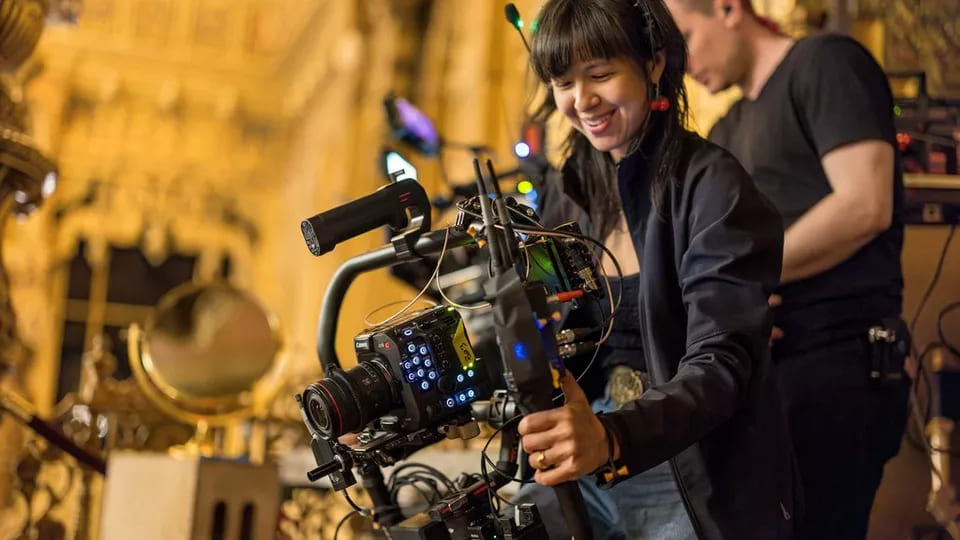Adapting to the evolving needs of the market and designed with versatility in mind, the EOS C400 offers an all-in-one solution tailored to support a vast range of different productions, from indie cinema and documentary, live and virtual broadcasts to the electronic news gathering field.
The EOS C400 is the first high-end RF mount cinema EOS camera, ushering in a groundbreaking new era for Canon products particularly within the EOS R System. Compact yet mighty, the innovative design packs advanced features and specifications typically found in larger cameras into a more nimble box shaped design, prioritising ease of use and operability without compromising on capability. Moreover, specific in-camera connectivity such as genlock, return input and 12-pin lens terminal all support live multi-camera productions.
BSI sensor and triple ISO
The EOS C400 is equipped with a cutting-edge 6K full frame backside-illuminated, stacked CMOS sensor (BSI), boasting 16 stops of dynamic range. The technology enhances light capture efficiency and facilitates faster readouts, ensuring superior image quality.
Setting a new standard, the camera introduces the Canon triple base ISO technology, crafted for optimal performance in low light environments and delivering the cleanest optical results. With base ISO levels of 800, 3,200 and 12,800 when shooting in Canon Log 2 or 3, users have greater flexibility when it comes to shooting in challenging lighting conditions.
To make the shooting process that much easier, an automatic switching mode detects ambient lighting and adjusts the base ISO level accordingly, enhancing the overall user experience.
RF mount
Supporting Canon RF mount technology, the EOS C400 seamlessly integrates with a wide array of RF prime, zoom, hybrid, cinema and VR lenses. For added flexibility without the need for third party accessories, the camera also supports the option to use a variety of Canon’s EF-EOS R mount adapters as well as the new PL-RF mount adaptor. Additionally, the camera has enhanced metadata capabilities and connectivity options facilitating real time frame-by-frame data capture enhancing both VFX and Virtual Production workflows.
Dual Pixel CMOS AF II
Canon is now introducing its Dual Pixel CMOS AF II to its cinema EOS system, providing filmmakers with improved autofocus features. With comprehensive 100% coverage across the sensor plane, the Dual Pixel CMOS AF II delivers swift and precise performance, upgrading filmmaking clarity and reliability whilst providing piece-of-mind that you are nailing the shot every time.
This latest system also unlocks additional benefits such as face/ eye/ body tracking and animal detection and tracking, especially useful when working solo in a fast-paced environment.
Recording formats
With more options when it comes to internal recording formats, users can now tailor the format to suit their specific needs. Options include Canon’s scalable 12-bit Cinema RAW Light LT/ ST/ HQ, reliable 4:2:2 10-bit XF-AVC and all-new MP4 based XF-AVC S and XF-HEVC S formats, accommodating several types of professional requirements. All of which accommodate detailed filmmaking workflows with professional filename and metadata support.

Compact design
Users familiar with the EOS C500 Mark II will appreciate the EOS C400’s recognisable design, now upgraded with an even more compact form while still offering an extensive array of connectivity. This enables operators to access the full suite of features typically associated with larger scale production cameras without the burden of size, weight or attaching additional modules.
The new compact design and enhanced accessories such as a versatile LCD bracket, advanced top handle and improved hand grip offer compatibility with a range of shooting styles whether handheld, on a gimbal, drone or shoulder-mounted.
Introducing the latest Cine Servo lens
The all new CN7x17 KAS T available with either RF or PL mount sits within the Canon Cine Servo lens range, an evolution to the previous CN7x lens but with improved updates designed to bolster operational performance and extend compatibility with virtual and VFX workflows.
With an expansive 7x optical zoom and 17-120mm focal length, the lens appeals to live sports and news, documentary, film, remote and virtual productions. 11 iris blades produce softly diffused highlights and silky out of focus backgrounds.
Among its standout features are improved connectivity between the lens and camera, streamlining processes such as real-time lens distortion correction, frame by frame lens metadata and virtual production workflows with an Unreal Engine plug-in tailored for the EOS C400. The PL mount variant of the lens supports both Cooke /i TechnologyTM and ZEISS eXtended DataTM for lens metadata and distortion/ shading correction1.
Decked with the state-of-the art next-generation e-Xs V digital drive unit, the CN7x17 KAS T features advanced functionalities including optical focus breathing correction, faster iris control and a convenient USB-C interface for remote control and user setting transfer.
EOS C300 Mark III firmware update
Canon is also releasing a free-of-charge firmware update for the EOS C300 Mark III, adding 12-bit Cinema RAW Light formats: LT (Light), ST (Standard) and HQ (High Quality), improving workflow flexibility and providing more options post-production. An Auto ISO feature will also be made available to seamlessly transition between dynamic lighting conditions in a continuous shot.
Canon today also introduces the RF 35mm F1.4L VCM, a first of its kind hybrid lens designed to capture both stills and video, along with the new Speedlite EL-10 for elevating portraits with controllable lighting.
For more information about these products, please visit:
EOS C400: https://en.canon-me.com/cameras/eos-c400/
CN7x17 KAS T: https://en.canon-me.com/pro/cinema-lenses/cn7x17-kas-t/
EOS C300 Mark III firmware update: https://en.canon-me.com/video-cameras/eos-c300-mark-iii/









